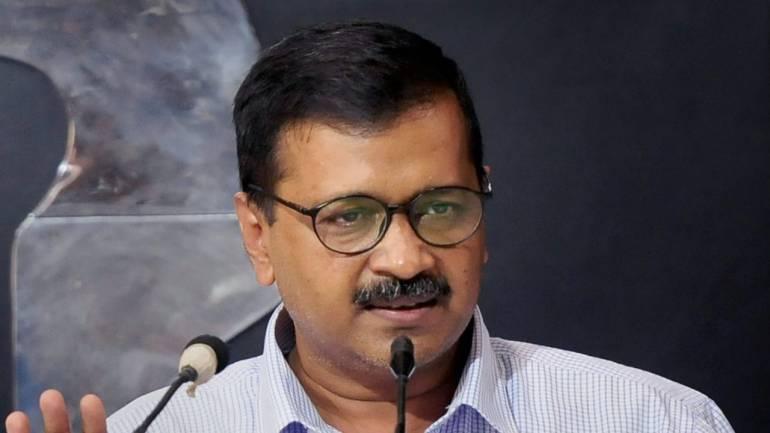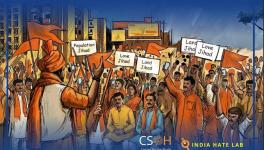Kejriwal Isn’t Communal, But His Desire Not to be Seen Anti-Hindu May Prove Self-Defeating

The end justifies the means—this is the essence of the Aam Aadmi Party government’s decision to sanction the prosecution of Communist Party of India leader Kanhaiya Kumar in the sedition case of 2016.
The end is to deny the Bharatiya Janata Party the opportunity of labeling the AAP and its leader, Arvind Kejriwal, as anti-national and anti-Hindu, which are presumed to be obstacles impossible to surmount in any election in the Hindi heartland.
The means: it all depends on the exigency of the circumstance.
For the moment, it is Kejriwal’s conscious decision to dispel any notion that he is sympathetic to Kumar and, therefore, anti-national. For the moment, it is also about accepting the narrative harping on the equivalence of losses that Hindus and Muslims suffered in the recent Delhi riot, and their roles in it.
The end-justifies-the-means approach to politics has as serious an implication as the accusation that the AAP and Kejriwal have joined the Hindu Right, or have become the B-team of the BJP, or have embraced Hindutva and its tendency to demonise Muslims.
AAP is certainly not the B-team of the BJP. Nor is it likely to target and discriminate against the Muslims, although Kejriwal seems decidedly shy of associating with them. This has dismayed a segment of Delhiites.
At the nub of their dismay is Kejriwal’s refusal to ideologically challenge the BJP, to even hit out at the saffron brigade for its gross excesses and glaring omissions. This is in sharp contrast to the time he would take swipes against the BJP on issues which were not his business. For instance, he accused Prime Minister Narendra Modi of falsifying his educational qualification. He alleged that the Modi government’s claim of inflicting losses on Pakistan through a surgical strike, in 2016, was plain fiction.
In those days, Kejriwal was obsessed with the idea of discrediting and vanquishing the BJP and Modi. He still is.
But the means to achieve that goal has changed—he will not challenge the BJP’s baiting of Muslims, as was palpable during the furious election campaign for the Delhi Assembly elections. He did not also accuse the BJP of organising the recent riots or asking for the resignation of Home Minister Amit Shah for the collapse of Delhi’s policing system, as AAP would certainly have, say, three years ago.
The explanation for the change in Kejriwal is presumably his conclusion that the strategy of frontally confronting the BJP does not pay—it drives away from AAP even those who have benefited tremendously from his policies.
After failing to win Punjab, which AAP was widely predicted to win, and a lackluster performance in Goa in 2017, the party lost the Delhi municipal election, and was relegated to the third spot in the 2019 Lok Sabha elections in terms of vote share.
It was then that the AAP decided to change the means to combat the BJP.
Kejriwal became quieter, supported the reading down of Art 370, and his party welcomed the Supreme Court judgment on the Ram temple in Ayodhya, as did most political parties in north India. The AAP voted against the Citizenship Amendment Act, but as the protest against it gathered momentum and the women of Shaheen Bagh occupied a busy road, Kejriwal lapsed into silence on the citizenship issue. He chose to focus on his governance model of efficiently, and cheaply, delivering public utility services, and revamping the healthcare and educational infrastructure.
His decision to skirt around the CAA issue had many to dub him as an opportunist, a political hypocrite. But with Shah and the BJP resorting to the tactics of communally polarising the electorate a fortnight before the elections, there were many who revised their view on his tactics. It was pragmatism, they thought.
But then, after winning the elections, Kejriwal dashed hopes of all those who thought he would now gun for the BJP. He did not in his speech delivered during the oath-taking ceremony.
His responses to the riot were disappointing, not least because of his little experience to handle social conflicts.
Yet the most significant reason for not firing volleys against the BJP was the findings of AAP’s surveys, which it regularly undertook during the election campaign. Until Shah stepped in with his brazen tactics of communally polarising the electorate late January, the BJP was predicted to win around 20% of votes. The BJP’s vote-share, in a matter 15 days, shot up steeply, ending up at nearly 40%.
The AAP reposed faith in its surveys because these had correctly, and consistently, found the party trailing in the eight constituencies they eventually lost in Delhi. These surveys had also shown that Modi’s popularity had not dipped since the 2019 Lok Sabha elections. The conclusion: many of those who had voted for AAP would switch their allegiance to the BJP in a Lok Sabha election.
These surveys have had the AAP to stick to the means adopted to win the Delhi elections. These means are: do not vilify Modi, do not go against the sentiments of Hindus. To put it in another way, the BJP should not be given the opportunity to depict Kejriwal and AAP as pro-Muslim. As long as that charge is shown to be hollow, AAP thinks it can lure the Hindus, as well as other communities, with its model of governance.
In other words, until the rightwing Hindu space that the BJP occupies shrinks, there is no hope for the Opposition, or so the AAP thinks. Many will, obviously, wonder why AAP should think of electoral strategy now, given that the party cannot be dislodged from power because of the majority it commands.
The answer is a short one: Kejriwal and AAP nurse the ambition of building their dovecotes in other states.
They will seek to conquer Punjab and Goa, both of which will go to the polls in 2022. It is moot whether the strategy of sporting the veneer of a political Hindu party will succeed in Punjab, where the Sikhs dominate, and even in Goa, which has Christians accounting for 25 percent of its population. A Samajwadi Party leader, in Uttar Pradesh, told this writer that he was recently approached to join the AAP, but he refused.
AAP’s decision to adopt Hanuman, who is considered the god of the plebian, is a means to challenge the BJP’s monopoly of Hinduism—and expand at its expense.
A variation of this theme was tried by Congress president Rahul Gandhi, who went on a temple spree and was projected as a janeu-wearing Brahmin and Shiv bhakt to boot. His success was limited—the Congress pipped the BJP at the post in Rajasthan and Madhya Pradesh, and improved upon its past performance in Gujarat, but it was blown away, in the 2019 national election, in these three states.
These examples show the pitfalls inherent in the AAP’s emphasis on its Hinduness. Superficial demonstration of the Hindu identity, whether by AAP now and the Congress earlier, is very unlikely to impress the Hindus, who have been, over the years, made to believe that they are besieged by Muslims. The BJP will invent new methods of fanning their imagined insecurities and anxieties, and multiplying their grievances.
On this count at least, it is impossible for AAP to counter the BJP, unless we presume that the former, subscribing to the-end-justifies-the-means approach, will even resort to the latter’s style of acrimonious, abrasive politics.
Indeed, the limitation of AAP’s attempt to appear neither anti-Hindu nor pro-Muslim is evident from its response to the Delhi riots. This writer does not include in the weak response the puerile thinking that had Kejriwal parachuted at the site where the Delhiites were killing each other, the violence would have magically stopped.
The assailants were trucked into Delhi from outside; they were there to kill and plunder. Kejriwal is no Gandhi. No Indian politician is. The sheer helplessness of people against Hindutva mobs has us pine for a Gandhi in our midst
But it is hard to figure out why, after the riots ceased, Kejriwal has been only once to the sites of death and devastation. The AAP has belatedly stepped on the pedal organise relief and rehabilitation.
Yet, as Delhi chief minister, Kejriwal has to initiate reconciliation between the Hindus and Muslims.
This is because the riots have overnight turned colonies, having both Hindu and Muslim residents, into homogeneous settlements. Until the displaced Hindus and Muslims return where they once lived, the social milieu will only be conducive for Hindutva to flourish
This requires hard work and, above all, taking risks, which the-end-justifies-the-means approach—or, in other words, appear neither anti-Hindu nor pro-Hindu—might hamstring AAP from doing so. Unless the severed social bonds between the Hindus and Muslims are re-forged, and they are taught not to hate each other, the BJP’s grip over the Hindus and Hinduism will not be weakened.
A few defeats will then have Kejriwal to think of yet another strategy to weaken the BJP, which is certainly his aim. And so it will be that the AAP will go round and round, as if perched on a merry-go-round, seemingly circumscribed to even take a decision on whether it will oppose the exercise to prepare the National Population Register, which asks respondents to list the place and date of birth of parents, much to the fear of many.
The author is a freelance journalist. The views are personal.
Get the latest reports & analysis with people's perspective on Protests, movements & deep analytical videos, discussions of the current affairs in your Telegram app. Subscribe to NewsClick's Telegram channel & get Real-Time updates on stories, as they get published on our website.
























